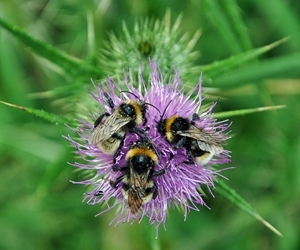 A new study published in the science journal Biological Conservation identified that double the amount of uncultivated land currently being devoted to bees and other pollinators on farmland needs to be created to boost declining insects such as bees, butterflies and hoverflies.
A new study published in the science journal Biological Conservation identified that double the amount of uncultivated land currently being devoted to bees and other pollinators on farmland needs to be created to boost declining insects such as bees, butterflies and hoverflies.
The five-year study, which formed part of the Farm4bio project, and carried out by entomologists from the Game & Wildlife Conservation Trust (GWCT) and Rothamsted Research, suggests that at least a seven per cent increase in flower-rich habitat is needed in order to double pollinator abundance. The study was carried out in two regions of England – Wessex and East Anglia.
Dr John Holland, head of farmland ecology with the Game & Wildlife Conservation Trust explains the results of the study, “Our study confirmed that the lack of flower-rich habitat was a limiting factor in the recovery of wild bees, butterflies and other pollinators. However, the study showed that we do need to balance the creation of new flower-rich habitats to ensure this does not detract pollinating insects away from existing natural wild plants and crops that also need to attract pollinators. ”
To mitigate the large amount of uncultivated land needed for bees and butterflies, Dr Holland says that the study identified several ways in which the existing farmland landscapes can be improved for pollinators, thereby reducing the need to take more land out of production. He said, “It is vitally important to protect hedges and woodland edges from fertiliser and herbicide drift which can damage existing plant communities that provide preferred habitats for bumblebees such as carder bees and red tailed bees. These natural areas will also benefit other wildlife such as birds, small mammals and invertebrates.
“The quantity and quality of nesting sites may also determine wild bee abundance, but whether nest sites are a limiting factor in the UK remains uncertain”, explains Dr Holland
The study identified the importance of woodland edges for bees and butterflies and the need to increase management in these areas for the benefit of pollinators. Dr Holland explains, “Similar to farmland birds, wild bees can also suffer during the ‘hungry gap’ when there is little spare food available.
“When pollinators such as queen bumblebees come out of hibernation in early spring, they need an ample supply of nectar from spring flowers such as white-dead nettle, primrose, and bluebells, so that they can start a breeding colony. Woodland can therefore be a particularly important habitat for pollinators in the landscape during early spring. One of the key ways to maximise the pollen and nectar in these woodland areas is to create a diverse structure within the woodland by coppicing, and opening rides that help encourage the growth of flowers and a shrubby layer within the woodland. Flowering trees are also very important and given their size provide massive amounts of nectar and pollen.”
The study concluded that the success of current Agri-Environment Scheme (AES) habitats for pollinators is variable and depends on their type and quality, which is very much determined by their management. At present the uptake of flower-rich habitats within AES is low nationally, and the study showed that farmers need encouragement to try these options. Consequently the quality of advice provided by farm advisers is critical.
END
Photocaption: A new study by the Game & Wildlife Conservation Trust and Rothamsted research showed that double the amount of flower-rich land currently being devoted to bees and other pollinators on farmland needs to be created to boost declining insects such as bees, butterflies and hoverflies. Photocredit: Peter Thompson, GWCT.
Notes to editors:
The study, by Dr John Holland, Head of Farmland Ecology, with the Game & Wildlife Conservation Trust and Rothamsted Research is published in Biological Conservation and called ‘Managing habitats on English farmland for insect pollinator conservation'.
The study formed part of the Farm4bio project and was funded by the Sustainable Arable LINK programme supported by Defra, BASF, Bayer Crop Science Ltd, Processors and Growers Research Organisation, Syngenta Ltd, and The Arable Group.
The Game & Wildlife Conservation Trust (GWCT) – providing research-led conservation for a thriving countryside. The GWCT is an independent wildlife conservation charity which has carried out scientific research into Britain’s game and wildlife since the 1930s. We advise farmers and landowners on improving wildlife habitats and we lobby for agricultural and conservation policies based on science. We employ 22 post-doctoral scientists and 50 other research staff with expertise in areas such as birds, insects, mammals, farming, fish and statistics. We undertake our own research as well as projects funded by contract and grant-aid from Government and private bodies. The Trust is also responsible for a number of Government Biodiversity Action Plan species and is lead partner for grey partridge and joint lead partner for brown hare and black grouse. For Information, contact: Morag Walker – Head of Media, Telephone – direct-dial: 01425-651000. Mobile – 07736-124097 www.gwct.org.uk